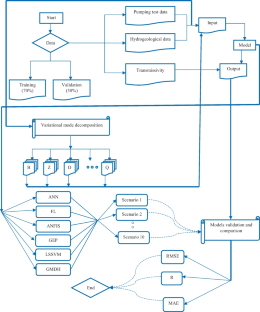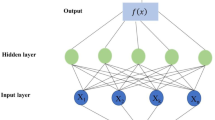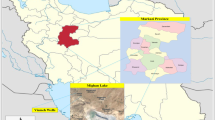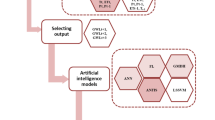Abstract
Groundwater management is key to attaining sustainable development goals, especially in arid and semi-arid countries. Hence, a precise estimate of the aquifer hydrodynamic parameters (hydraulic conductivity, transmissivity, specific yield, and storage coefficient) is required for proper groundwater resource management. The central goal of this research is to utilize machine learning models to estimate transmissivity by pumping test data in unconfined alluvial aquifers. Artificial neural network (ANN), gene expression programming (GEP), adaptive neuro-fuzzy inference system (ANFIS), fuzzy logic (FL), least square support vector machine (LSSVM), and group method of data handling (GMDH) methods were utilized to estimate transmissivity. To achieve this goal, pumping tests and hydrogeological data from 96 pumping wells located in the central plateau of Iran were collected and normalized. Using the existing normalized data, several combinations were utilized as inputs to the models, and then randomly, 70% of the data were used for the training step and 30% for the testing step. Finally, ten combinations that provided a better answer were selected from whole combinations. The mean absolute error, root means square error and correlation coefficient were used to assess the models' precision. The comparison criteria revealed that while all developed methods could provide desirable transmissivity estimations, the GMDH model was the most accurate and precise. The result of the models suggested that the best combination in transmissivity estimating was combination 3 (well discharge, thickness, depth of pumping well, and minimum and maximum time-drawdown data). Therefore, using this method and without graphic methods, it is feasible to estimate the transmissivity with acceptable accuracy in unconfined aquifers with similar hydrogeological and geological characteristics.






Similar content being viewed by others
Availability of Data and Materials
The data, models, and codes generated or used during the study are available from the corresponding author by request.
Abbreviations
- ACO:
-
Ant Colony Optimization
- AI:
-
Artificial Intelligence
- ANFIS:
-
Adaptive Neuro-Fuzzy Inference System
- ANN:
-
Artificial Neural Network
- CSA:
-
Crow Search Algorithm
- DE:
-
Differential Evolution
- FL:
-
Fuzzy Logic
- GA:
-
Genetic Algorithm
- GEP:
-
Gene Expression Programming
- GMDH:
-
Group Method of Data Handling
- HP:
-
Hydrodynamic Parameter
- LM:
-
Levenberg–Marquardt
- LSSVM:
-
Least Square Support Vector Machine
- MAE:
-
Mean Absolute Error
- MF:
-
Membership Functions
- ML:
-
Machine Learning
- MSE:
-
Means Squared Error
- PSO:
-
Particle Swarm Optimization
- R:
-
Correlation Coefficient
- RMSE:
-
Root Means Squared Error
- T:
-
Transmissivity
References
Arabameri A, Arora A, Pal SC, Mitra S, Saha A, Nalivan OA, Somayeh P, Moayedi H (2021) K-fold and state-of-the-art metaheuristic machine learning approaches for groundwater potential modelling. Water Resour Manag 35:1837–1869. https://doi.org/10.1007/s11269-021-02815-5
Ayvaz MT (2007) Simultaneous determination of aquifer parameters and zone structures with fuzzy c-means clustering and meta-heuristic harmony search algorithm. Adv Water Resour 30(11):2326–2338. https://doi.org/10.1016/j.advwatres.2007.05.009
Azari T, Samani N (2018) Modeling the Neuman’s well function by an artificial neural network for the determination of unconfined aquifer parameters. Comput Geosci 22(4):1135–1148. https://doi.org/10.1007/s10596-018-9742-8
Azari T, Samani N, Mansoori E (2015) An artificial neural network model for the determination of leaky confined aquifer parameters: an accurate alternative to type curve matching methods. Iran J Sci Technol (Sci) 39(4):463–472. https://doi.org/10.22099/IJSTS.2015.3389
Bahmani R, Ouarda TB (2021) Groundwater level modeling with hybrid artificial intelligence techniques. J Hydrol 595:125659. https://doi.org/10.1016/j.jhydrol.2020.125659
Balkhair KS (2002) Aquifer parameters determination for large diameter wells using neural network approach. J Hydrol 265(1–4):118–128. https://doi.org/10.1016/S0022-1694(02)00103-8
Bateni SM, Mortazavi-Naeini M, Ataie-Ashtiani B, Jeng DS, Khanbilvardi R (2015) Evaluation of methods for estimating aquifer hydraulic parameters. Appl Soft Comput 28:541–549. https://doi.org/10.1016/j.asoc.2014.12.022
Bear J (1979) Hydraulics of Groundwater. McGraw Hill Inc, New York, NY, pp 432
Ch S, Mathur S (2012) Particle swarm optimization trained neural network for aquifer parameter estimation. KSCE J Civ Eng 16(3):298–307. https://doi.org/10.1007/s12205-012-1452-5
Chang CC, Lin CJ (2011) LIBSVM: a library for support vector machines. ACM Trans Intell Syst Technol (TIST) 2(3):1–27. https://doi.org/10.1145/1961189.1961199
Chiu SL (1994) Fuzzy model identification based on cluster estimation. J Intell Fuzzy Syst 2(3):267–278. https://doi.org/10.3233/IFS-1994-2306
Cui F, Al-Sudani ZA, Hassan GS, Afan HA, Ahammed SJ, Yaseen ZM (2022) Boosted artificial intelligence model using improved alpha-guided grey wolf optimizer for groundwater level prediction: Comparative study and insight for federated learning technology. J Hydrol 606:127384. https://doi.org/10.1016/j.jhydrol.2021.127384
Das M, Bhattacharjya RK, Kartha SA (2023) ANN-SFLA based parameter estimation method for an unsaturated–saturated simulation model. Model Earth Syst Environ 1–15. https://doi.org/10.1007/s40808-023-01797-0
Dashti Z, Nakhaei M, Vadiati M, Karami GH, Kisi O (2023) A literature review on pumping test analysis (2000–2022). Environ Sci Pollut Res 30(4):9184–9206. https://doi.org/10.1007/s11356-022-24440-4
Delnaz A, Rakhshandehroo G, Nikoo MR (2019) Optimal estimation of unconfined aquifer parameters in uncertain environment based on fuzzy transformation method. Water Supply 19(2):444–450. https://doi.org/10.2166/ws.2018.089
Delnaz A, Rakhshandehroo G, Nikoo MR (2020) Confined aquifer’s hydraulic parameters estimation by a generalized regression neural network. Iran J Sci Technol Trans Civil Eng 44(1):259–269. https://doi.org/10.1007/s40996-019-00238-2
Ferreira C (2001) Gene expression programming: a new adaptive algorithm for solving problems. arXiv preprint cs/0102027. https://doi.org/10.48550/arXiv.cs/0102027
Ghobadi A, Cheraghi M, Sobhanardakani S, Lorestani B, Merrikhpour H (2022) Groundwater quality modeling using a novel hybrid data-intelligence model based on gray wolf optimization algorithm and multilayer perceptron artificial neural network: a case study in Asadabad Plain, Hamedan, Iran. Environ Sci Pollut Res 29(6):8716–8730. https://doi.org/10.1007/s11356-021-16300-4
Gholami V, Khaleghi MR, Pirasteh S, Booij MJ (2022) Comparison of self-organizing map, artificial neural network, and co-active neuro-fuzzy inference system methods in simulating groundwater quality: Geospatial artificial intelligence. Water Resour Manag 1–19. https://doi.org/10.1007/s11269-021-02969-2
Gupta PK, Maiti S (2023) Enhancing the prediction of hydraulic parameters using machine learning, integrating multiple attributes of GIS and geophysics. Hydrogeol J 31(2):501–520. https://doi.org/10.1007/s10040-022-02567-5
Ha D, Zheng G, Zhou H, Zeng C, Zhang H (2020) Estimation of hydraulic parameters from pumping tests in a multiaquifer system. Underground Space 5(3):210–222. https://doi.org/10.1016/j.undsp.2019.03.006
Heddam S, Ptak M, Sojka M, Kim S, Malik A, Kisi O, Zounemat-Kermani M (2022) Least square support vector machine-based variational mode decomposition: a new hybrid model for daily river water temperature modeling. Environ Sci Pollut Res 1–28. https://doi.org/10.1007/s11356-022-20953-0
Ivakhnenko AG (1971) Polynomial theory of complex systems. IEEE Trans Syst Man Cybern 4:364–378. https://doi.org/10.1109/TSMC.1971.4308320
Jang JS (1993) ANFIS: adaptive-network-based fuzzy inference system. IEEE Trans Syst Man Cybern 23(3):665–685. https://doi.org/10.1109/21.256541
Karahan H, Ayvaz MT (2008) Simultaneous parameter identification of a heterogeneous aquifer system using artificial neural networks. Hydrogeol J 16(5):817–827. https://doi.org/10.1007/s10040-008-0279-0
Khalaf S, Ahmed AO, Abdalla MG, El Masry AA (2017) Identification of hydraulic parameters of wadi el natrun pliocene aquifer using artificial neural network. Hydrol Current Res 8(267):2. https://doi.org/10.4172/2157-7587.1000267
Khedri A, Kalantari N, Vadiati M (2020) Comparison study of artificial intelligence method for short term groundwater level prediction in the northeast Gachsaran unconfined aquifer. Water Supply 20(3):909–921. https://doi.org/10.2166/ws.2020.015
Khorrami B, Ali S, Gündüz O (2023) Investigating the local-scale fluctuations of groundwater storage by using downscaled GRACE/GRACE-FO JPL mascon product Based on Machine Learning (ML) Algorithm. Water Resour Manag 1–18. https://doi.org/10.1007/s11269-023-03509-w
Kisi O (2015) Pan evaporation modeling using least square support vector machine, multivariate adaptive regression splines and M5 model tree. J Hydrol 528:312–320. https://doi.org/10.1016/j.jhydrol.2015.06.052
Lin GF, Chen GR (2006) An improved neural network approach to the determination of aquifer parameters. J Hydrol 316(1–4):281–289. https://doi.org/10.1016/j.jhydrol.2005.04.023
Lin HT, Ke KY, Chen CH, Wu SC, Tan YC (2010) Estimating anisotropic aquifer parameters by artificial neural networks. Hydrol Process 24(22):3237–3250. https://doi.org/10.1002/hyp.7750
Mantoglou A (2003) Estimation of heterogeneous aquifer parameters from piezometric data using ridge functions and neural networks. Stoch Env Res Risk Assess 17(5):339–352. https://doi.org/10.1007/s00477-003-0155-3
Mathon BR, Ozbek MM, Pinder GF (2008) Transmissivity and storage coefficient estimation by coupling the Cooper-Jacob method and modified fuzzy least-squares regression. J Hydrol 353(3–4):267–274. https://doi.org/10.1016/j.jhydrol.2008.02.004
Mehdizadeh S, Behmanesh J, Khalili K (2017) Application of gene expression programming to predict daily dew point temperature. Appl Therm Eng 112:1097–1107. https://doi.org/10.1016/j.applthermaleng.2016.10.181
Minasny B, McBratney AB (2002) The neuro-m method for fitting neural network parametric pedotransfer functions. Soil Sci Soc Am J 66(2):352–361. https://doi.org/10.2136/sssaj2002.3520
Mohammed M, Sharafati A, Al-Ansari N, Yaseen ZM (2020) Shallow foundation settlement quantification: application of hybridized adaptive neuro-fuzzy inference system model. Adv Civil Eng. https://doi.org/10.1155/2020/7381617
Mozaffari S, Javadi S, Moghaddam HK, Randhir TO (2022) Forecasting groundwater levels using a hybrid of support vector regression and particle swarm optimization. Water Resour Manag 36(6):1955–1972. https://doi.org/10.1007/s11269-022-03118-z
Najafzadeh M, Homaei F, Mohamadi S (2022) Reliability evaluation of groundwater quality index using data-driven models. Environ Sci Pollut Res 29(6):8174–8190. https://doi.org/10.1007/s11356-021-16158-6
Nariman-Zadeh N, Darvizeh A, Darvizeh M, Gharababaei H (2002) Modelling of explosive cutting process of plates using GMDH-type neural network and singular value decomposition. J Mater Process Technol 128(1–3):80–87. https://doi.org/10.1016/S0924-0136(02)00264-9
Neuman SP (1975) Analysis of pumping test data from anisotropic unconfined aquifers considering delayed gravity response. Water Resour Res 11(2):329–342. https://doi.org/10.1029/WR011i002p00329
Nourani V, Mousavi S (2016) Spatiotemporal groundwater level modeling using hybrid artificial intelligence-meshless method. J Hydrol 536:10–25. https://doi.org/10.1016/j.jhydrol.2016.02.030
Ozturk M, Salman O, Koc M (2011) Artificial neural network model for estimating the soil temperature. Can J Soil Sci 91(4):551–562. https://doi.org/10.4141/cjss10073
Pan Z, Lu W, Wang H, Bai Y (2022) Fast inverse estimation of hydraulic conductivity field based on a deep convolutional-cycle generative adversarial neural network. J Hydrol 613:128420. https://doi.org/10.1016/j.jhydrol.2022.128420
Patel S, Eldho TI, Rastogi AK (2020) Hybrid-metaheuristics based inverse groundwater modelling to estimate hydraulic conductivity in a nonlinear real-field large aquifer system. Water Resour Manage 34:2011–2028. https://doi.org/10.1007/s11269-020-02540-5
Pham QB, Kumar M, Di Nunno F, Elbeltagi A, Granata F, Islam ARM, Talukdar S, Nguyen XC, Ahmed AN, Anh DT (2022) Groundwater level prediction using machine learning algorithms in a drought-prone area. Neural Comput Appl 1–23. https://doi.org/10.1007/s00521-022-07009-7
Prasad KL, Rastogi AK (2001) Estimating net aquifer recharge and zonal hydraulic conductivity values for Mahi Right Bank Canal project area, India by genetic algorithm. J Hydrol 243(3–4):149–161. https://doi.org/10.1016/S0022-1694(00)00364-4
Rahbar A, Mirarabi A, Nakhaei M, Talkhabi M, Jamali M (2022) A comparative analysis of data-driven models (SVR, ANFIS, and ANNs) for daily karst spring discharge prediction. Water Resour Manag 36(2):589–609. https://doi.org/10.1007/s11269-021-03041-9
Raheja H, Goel A, Pal M (2022) Prediction of groundwater quality indices using machine learning algorithms. Water Pract Technol 17(1):336–351. https://doi.org/10.2166/wpt.2021.120
Rajesh M, Kashyap D, Hari Prasad KS (2010) Estimation of unconfined aquifer parameters by genetic algorithms. Hydrol Sci J 55(3):403–413. https://doi.org/10.1080/02626661003738167
Razzagh S, Sadeghfam S, Nadiri AA, Busico G, Ntona MM, Kazakis N (2022) Formulation of Shannon entropy model averaging for groundwater level prediction using artificial intelligence models. Int J Environ Sci Technol 19(7):6203–6220. https://doi.org/10.1007/s13762-021-03793-2
Roshni T, Jha MK, Deo RC, Vandana A (2019) Development and evaluation of hybrid artificial neural network architectures for modeling spatio-temporal groundwater fluctuations in a complex aquifer system. Water Resour Manag 33:2381–2397. https://doi.org/10.1007/s11269-019-02253-4
Saha S, Mallik S, Mishra U (2022) Groundwater depth forecasting using machine learning and artificial intelligence techniques: A survey of the literature. recent developments in sustainable infrastructure (ICRDSI-2020)—GEO-TRA-ENV-WRM 153–167. https://doi.org/10.1007/978-981-16-7509-6_13
Sahour S, Khanbeyki M, Gholami V, Sahour H, Kahvazade I, Karimi H (2023) Evaluation of machine learning algorithms for groundwater quality modeling. Environ Sci Pollut Res 30(16):46004–46021. https://doi.org/10.1007/s11356-023-25596-3
Samani N, Gohari-Moghadam M, Safavi AA (2007) A simple neural network model for the determination of aquifer parameters. J Hydrol 340(1–2):1–11. https://doi.org/10.1016/j.jhydrol.2007.03.017
Samani S, Vadiati M, Azizi F, Zamani E, Kisi O (2022) Groundwater level simulation using soft computing methods with emphasis on major meteorological components. Water Resour Manag 36(10):3627–3647. https://doi.org/10.1007/s11269-022-03217-x
Samuel MP, Jha MK (2003) Estimation of aquifer parameters from pumping test data by genetic algorithm optimization technique. J Irrig Drain Eng 129(5):348–359. https://doi.org/10.1061/(ASCE)0733-9437(2003)129:5(348)
Sanikhani H, Kisi O (2012) River flow estimation and forecasting by using two different adaptive neuro-fuzzy approaches. Water Resour Manag 26(6):1715–1729. https://doi.org/10.1007/s11269-012-9982-7
Shigidi A, Garcia LA (2003) Parameter estimation in groundwater hydrology using artificial neural networks. J Comput Civ Eng 17(4):281–289. https://doi.org/10.1061/(ASCE)0887-3801(2003)17:4(281)
Sobhani J, Najimi M, Pourkhorshidi AR, Parhizkar T (2010) Prediction of the compressive strength of no-slump concrete: A comparative study of regression, neural network and ANFIS models. Constr Build Mater 24(5):709–718. https://doi.org/10.1016/j.conbuildmat.2009.10.037
Suryanarayana C, Sudheer C, Mahammood V, Panigrahi BK (2014) An integrated wavelet-support vector machine for groundwater level prediction in Visakhapatnam, India. Neurocomputing 145:324–335. https://doi.org/10.1016/j.neucom.2014.05.026
Suykens JAK, Vanderwalle J (1999) Least square support vector machine classifier. Neural Process Lett 9:293–300. https://doi.org/10.1023/A:1018628609742
Tabari MR, M., Azari, T., & Dehghan, V. (2021) A supervised committee neural network for the determination of aquifer parameters: a case study of Katasbes aquifer in Shiraz plain. Iran Soft Computing 25(6):4785–4798. https://doi.org/10.1007/s00500-020-05487-2
Tadj W, Chettih M, Mouattah K (2021) A new hybrid algorithm for estimating confined and leaky aquifers parameters from transient time-drawdown data. Soft Comput 25(24):15463–15476. https://doi.org/10.1007/s00500-021-06224-z
Tao H, Hameed MM, Marhoon HA, Zounemat-Kermani M, Heddam S, Kim S, Sulaiman SO, Tan ML, Sa’adi, Z., Danandeh Mehr, A., Allawi, M. F., Abba, S.I., Zain, J. M., Falah, M. W., Jamei, M., Dhanraj Bokde, M., Bayatvarkeshi, M., Al-Mukhtar, M., Bhagat, S. K., Tiyasha, T., Khedher, K. M., Al-Ansari, N., Shahid, S., Yaseen, Z. M. (2022) Groundwater level prediction using machine learning models: a comprehensive review. Neurocomputing. https://doi.org/10.1016/j.neucom.2022.03.014
Vakhshouri B, Nejadi S (2018) Prediction of compressive strength of self-compacting concrete by ANFIS models. Neurocomputing 280:13–22. https://doi.org/10.1016/j.neucom.2017.09.099
Vu MT, Jardani A (2022) Multi-task neural network in hydrological tomography to map the transmissivity and storativity simultaneously: HT-XNET. J Hydrol 612:128167. https://doi.org/10.1016/j.jhydrol.2022.128167
Vu MT, Jardani A (2023) Multitasking neural network to jointly map discrete fracture structures and matrix transmissivity by inverting hydraulic data acquired in 2D fractured aquifers. XNET-fracture. Adv Water Resour 177:104463. https://doi.org/10.1016/j.advwatres.2023.104463
Wang WY, Kang JT, Li K, Fan YH, Lin P (2022) A Novel intelligent inversion method of hydrogeological parameters based on the disturbance-inspired equilibrium optimizer. Sustainability 14(6):3267. https://doi.org/10.3390/su14063267
Xue P, Wen Z, Zhao D, Jakada H, Liang X (2021) Determination of hydraulic conductivity and its spatial variability in the Jianghan Plain using a multi-format, multi-method approach. J Hydrol 594:125917. https://doi.org/10.1016/j.jhydrol.2020.125917
Yeh HD, Lin YC, Huang YC (2007) Parameter identification for leaky aquifers using global optimization methods. Hydrol Process Int J 21(7):862–872. https://doi.org/10.1002/hyp.6274
Yuan Z, Wang LN, Ji X (2014) Prediction of concrete compressive strength: Research on hybrid models genetic based algorithms and ANFIS. Adv Eng Softw 67:156–163. https://doi.org/10.1016/j.advengsoft.2013.09.004
Zheng G, Ha D, Loaiciga H, Zhou H, Zeng C, Zhang H (2019) Estimation of the hydraulic parameters of leaky aquifers based on pumping tests and coupled simulation/optimization: Verification using a layered aquifer in Tianjin, China. Hydrogeol J 27(8):3081–3095. https://doi.org/10.1007/s10040-019-02021-z
Acknowledgements
Iran Water Resources Management Company issued the data used in this research. The authors thank Iran Water Resources Management Company for providing the pumping test data.
Author information
Authors and Affiliations
Contributions
Z. Dashti and M. Vadiati analyzed and interpreted data and contributed to writing the manuscript. M. Nakhaei and G.H. Karami contributed to the interpretation and manuscript revision. O. Kisi was involved in revising the manuscript critically for important intellectual content. All authors read and approved the final manuscript.
Corresponding author
Ethics declarations
Ethical Approval
Not applicable because this article does not contain any studies with human or animal subjects.
Consent to Participate
Not applicable.
Consent to Publish
We, the undersigned, give us consent to publish identifiable details, including text, figures, and tables, in the journal.
Conflict of Interest
The authors declare no conflict of interest.
Additional information
Publisher's Note
Springer Nature remains neutral with regard to jurisdictional claims in published maps and institutional affiliations.
Rights and permissions
Springer Nature or its licensor (e.g. a society or other partner) holds exclusive rights to this article under a publishing agreement with the author(s) or other rightsholder(s); author self-archiving of the accepted manuscript version of this article is solely governed by the terms of such publishing agreement and applicable law.
About this article
Cite this article
Dashti, Z., Nakhaei, M., Vadiati, M. et al. Estimation of Unconfined Aquifer Transmissivity Using a Comparative Study of Machine Learning Models. Water Resour Manage 37, 4909–4931 (2023). https://doi.org/10.1007/s11269-023-03588-9
Received:
Accepted:
Published:
Issue Date:
DOI: https://doi.org/10.1007/s11269-023-03588-9




